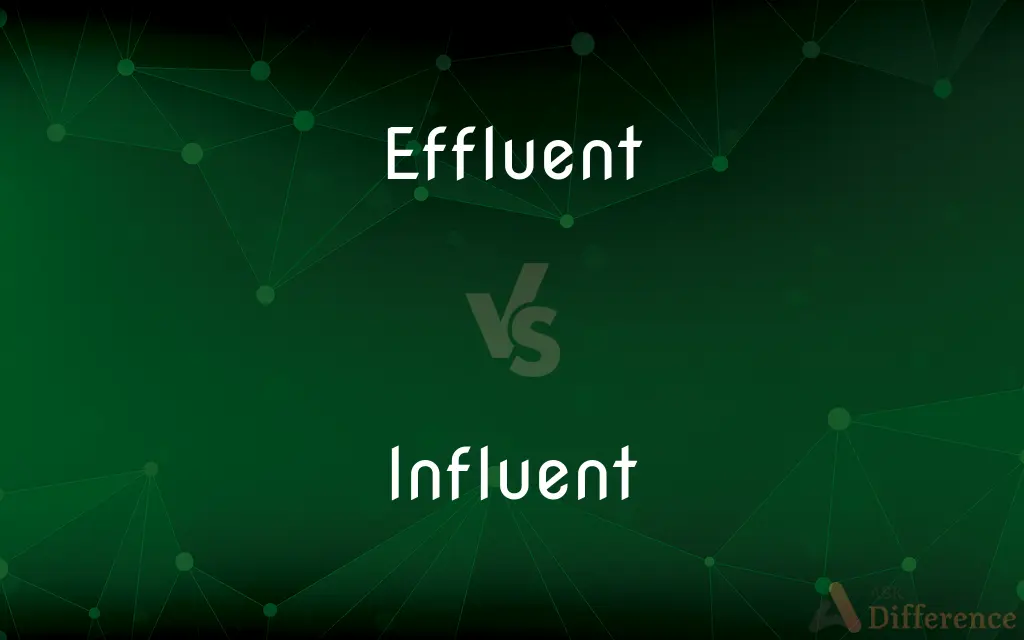Effluent vs. Influent — What's the Difference?
By Tayyaba Rehman — Updated on May 29, 2024
Effluent is wastewater or pollution discharged into a natural body of water, while influent is water, liquid or fluid flowing into a reservoir or treatment plant.

Difference Between Effluent and Influent
Table of Contents
ADVERTISEMENT
Key Differences
Effluent and influent are terms often associated with water treatment and environmental engineering. Effluent refers to the liquid waste or sewage discharged into a river or the sea. In contrast, influent denotes any incoming water or liquid flowing into a treatment system or reservoir. Effluent is what has been processed and is exiting the system, whereas influent is unprocessed and entering the system.
Effluent is typically the byproduct of a process, such as the treated wastewater from industrial processes or sewage plants. This term is also used to describe emissions released into the air. Influent, on the other hand, describes a substance that is incoming, like water entering a purification system or a stream feeding into a lake. Effluent can often be harmful to the environment if not properly treated, while influent is necessary to sustain the system being fed.
In environmental contexts, controlling effluent is crucial to preventing pollution. Regulations are in place to manage the quality and quantity of effluent released. Influent, conversely, can be sourced from natural or artificial means and is considered essential for the functioning of water treatment facilities. Effluent's quality directly depends on the influent and the treatment processes it undergoes.
The focus with effluent is on the output, ensuring it meets environmental safety standards. With influent, the concern is often about the quality and quantity of what is being received and how it can be best treated or utilized. Effluent requires monitoring and often treatment before it can be returned to the environment safely. In contrast, influent must be measured and analyzed to ensure the right treatment methods are applied.
Effluent and influent serve as indicators of a system's health and efficiency. The composition of effluent can signal the effectiveness of a treatment plant. The nature of influent, whether it is rainwater, surface water, or sewage, determines the treatment needs. Effluent impacts the environment upon release, while influent's impact is on the system it enters.
ADVERTISEMENT
Comparison Chart
Definition
Liquid waste discharged into the environment
Water or liquid entering a system
Direction of Flow
Outward from a system
Into a system
Associated With
Emissions, discharge, outflow
Intake, inflow, incoming water
Treatment Focus
Post-treatment quality control
Pre-treatment analysis and preparation
Environmental Impact
Potential pollutant if untreated
Source of system input, requires monitoring
Compare with Definitions
Effluent
Treated water exiting a treatment plant.
The effluent from the facility flows into the river.
Influent
Fluid that impacts a system's operation.
They measured the volume of influent daily.
Effluent
Emissions released into the air or water.
Factory effluent has decreased since the new filters were installed.
Influent
Liquid entering a reservoir.
The dam's influent comes from the mountain streams.
Effluent
Outflow of liquid waste.
Industrial effluent can be a major pollutant.
Influent
Raw water before treatment.
The influent quality affects the treatment process.
Effluent
Wastewater discharged into the environment.
Strict regulations govern the release of effluent into lakes.
Influent
An inflow, especially a tributary.
Effluent
A discharge of liquid waste, as from a factory or nuclear plant.
Influent
Water flowing into a treatment system.
The influent at the north end is rich in nutrients.
Effluent
The substance flowing out of a container.
The effluent was steadily dripping from the tank.
Influent
Flowing in
Some particles delivered in the influent streams settle in the reservoirs
Effluent
Effluent is an outflowing of water or gas to a natural body of water, from a structure such as a sewage treatment plant, sewer pipe, industrial wastewater treatment plant or industrial outfall. Effluent, in engineering, is the stream exiting a chemical reactor.
Influent
A stream, especially a tributary, which flows into another stream or lake.
Effluent
Liquid waste or sewage discharged into a river or the sea
Industrial effluent
Contamination with trade effluents
Influent
Flowing in or into.
Effluent
Flowing out or forth.
Influent
A stream which flows into another stream or a lake.
Effluent
A stream flowing out of a body of water.
Influent
Fluids flowing in.
Effluent
An outflow from a sewer or sewage system.
Influent
(ecology) An organism having an important effect on a plant or animal community.
Effluent
Flowing out; outflowing.
Influent
Flowing in.
Effluent
(countable) A stream that flows out, such as from a lake or reservoir; an outflow; effluence.
Influent
Exercising astral influence.
Effluent
Sewage water that has been (partially) treated, and is released into a natural body of water; a flow of any liquid waste.
Influent
(ecology) Having an important effect on a plant or animal community.
Effluent
Flowing out; as, effluent beams.
Influent
Flowing in.
Effluent
A stream that flows out of another stream or lake.
Influent
Exerting influence; influential.
I find no office by name assigned unto Dr. Cox, who was virtually influent upon all, and most active.
Effluent
Water mixed with waste matter
Influent
That is flowing inward
Effluent
That is flowing outward
Influent
Substance or fluid going into a container.
The influent pipe was clogged with debris.
Common Curiosities
What is effluent?
Effluent is wastewater that is discharged into the environment after treatment.
Can influent be a source of pollution?
Influent can carry pollutants that need to be treated.
Can effluent be reused?
Treated effluent can sometimes be reused for irrigation or industrial processes.
How is effluent treated?
Effluent is treated through physical, chemical, and biological processes to remove contaminants.
How is influent measured?
Influent is measured by volume or flow rate and is analyzed for contaminants.
How does influent affect water treatment costs?
Poor influent quality can increase treatment costs due to the need for more advanced processes.
Are there regulations for effluent?
Yes, there are strict regulations for effluent discharge to protect the environment.
Is all effluent water-based?
While typically water-based, effluent can also refer to emissions into the air.
Is effluent always polluted?
Effluent often contains pollutants but should be treated to safe levels before discharge.
What is influent?
Influent is the raw water or liquid that enters a treatment system.
Why is the quality of influent important?
The quality of influent affects the treatment process's complexity and effectiveness.
Is influent testing necessary?
Yes, testing influent helps determine the required treatment processes.
What happens if effluent standards are not met?
Non-compliance with effluent standards can lead to legal action and environmental harm.
Can influent come from different sources?
Yes, influent can originate from surface water, groundwater, or sewage.
Can effluent impact public health?
Improperly treated effluent can impact public health by contaminating water sources.
Share Your Discovery

Previous Comparison
Whortleberry vs. Blueberry
Next Comparison
Hiree vs. HireAuthor Spotlight
Written by
Tayyaba RehmanTayyaba Rehman is a distinguished writer, currently serving as a primary contributor to askdifference.com. As a researcher in semantics and etymology, Tayyaba's passion for the complexity of languages and their distinctions has found a perfect home on the platform. Tayyaba delves into the intricacies of language, distinguishing between commonly confused words and phrases, thereby providing clarity for readers worldwide.













































